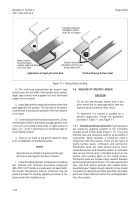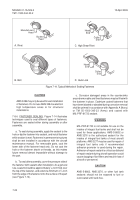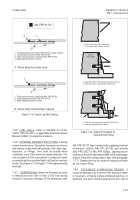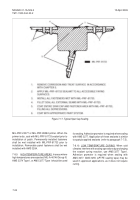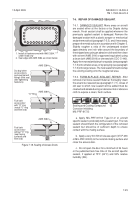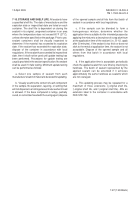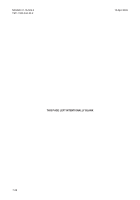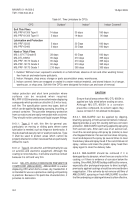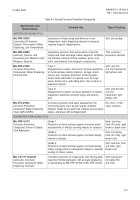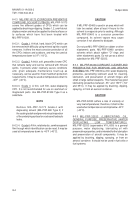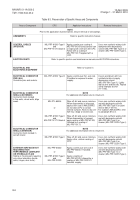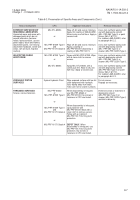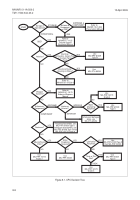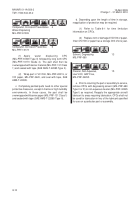TM-1-1500-344-23-2 - Page 145 of 240
8-1
NAVAIR 01-1A-509-2
TM 1-1500-344-23-2
15 April 2009
8-1. INTRODUCTION.
Corrosion preventive
compounds (CPCs), or preservatives, are used to protect
metal aircraft parts and components. They function by
preventing corrosive materials from contacting and
corroding bare metal surfaces. Many of these
compounds are also able to displace water, sea water,
and other contaminants from the surfaces to be
protected. Some provide lubrication, as well as corrosion
protection. Generally, CPCs are mixtures of special
additives in petroleum derivative bases (special oils or
greases). CPCs range in appearance and consistency
from the thick, black types, such as MIL-PRF-16173
Grade 1, to light oils, such as MIL-PRF-32033 (formerly
VV-L-800). The thicker CPCs provide the best corrosion
protection, are longer lasting, and are more difficult to
remove. The thinner materials provide some lubrication
and do not crack, chip or peel but must be removed and
replaced regularly to provide continuing protection.
Navy: refer to NAVAIR 15-01-500 for detailed information
on preservation of aircraft and components.
8-2. OPERATIONAL PRESERVATION
. The day to
day application of CPCs to prevent corrosion on
operational aircraft is known as operational preservation.
Areas which are corrosion prone or where paint has
been damaged should be routinely protected by CPCs
until more permanent treatment (such as paint touchup
or sealing) can be accomplished.
8-3. NON-OPERATIONAL
PRESERVATION
.
Preservation of aircraft or components during periods of
prolonged inactivity, storage, or shipment is known as
non-operational preservation.
8-4. TYPES OF CPCS
. CPCs can be separated into
two major categories: water displacing and non-water
displacing compounds.
8-4.1. WATER DISPLACING COMPOUNDS. Water
displacing CPCs can be used to remove water, sea
water, or other electrolytes from metal surfaces.
MIL-PRF-81309, MIL-DTL-85054, MIL-PRF-63460, and
MIL-PRF-32033 are examples of water displacing CPCs.
These CPCs are able to penetrate into cracks, crevices,
voids in faying edges, around fastener heads, and into
hinges. They usually provide very thin coatings, one mil
(0.001 inch) or less in thickness (a dollar bill is five mils
thick), and are usually clear or translucent. Most water
displacing compounds are soft, oily compounds which
cannot provide long term protection outdoors or in
areas which are frequently handled. MIL-DTL-85054
differs from the other water displacing compounds by
forming a relatively hard, dry film, and can be used for
protection outdoors and in areas of frequent handling.
8-4.2. NON-WATER DISPLACING COMPOUNDS.
Non-water displacing CPCs may be used on dried
surfaces or on surfaces which have been first treated
with a water displacing CPC. MIL-PRF-16173, Grades 1,
2 and 4, are examples of non-water displacing CPCs.
They are heavier bodied oils or greases which provide
long term corrosion protection. These CPCs provide
thicker coatings and are light brown to very dark brown
in color, with a waxy greasy appearance. They provide
good corrosion protection in areas where large amounts
of water collect on or run off of structures. MIL-L-87177
Grade B is a corrosion inhibiting and lubricating CPC
that provides longer outdoor protection than
MIL-PRF-81309 and MIL-PRF-32033 and can be used
for corrosion protection when ultra-penetrating properties
are not required.
8-5. TIME LIMITATIONS OF CPCS
. Because of their
temporary nature, CPCs must be regularly removed
and replaced to provide continuing corrosion protection.
Table 8-1 provides the recommended time intervals for
indoor and outdoor CPC application. Navy: Refer to
NAVAIR 15-01-500 for further information on usage of
CPCs.
8-6. DESCRIPTION OF CPCS
. A list of CPCs and
their intended uses is summarized in Table 8-2.
WARNING
MIL-PRF-81309 and MIL-DTL-85054 have been
revised to eliminate Ozone Depleting
Substances (ODS). Some products that have
been reformulated are now flammable. Pay
close attention to all CAUTION/WARNING
labels on solvents and solvent-based products.
8-6.1. MIL-PRF-81309 (CORROSION PREVENTIVE
COMPOUND, WATER DISPLACING, ULTRA THIN
FILM). MIL-PRF-81309 is a general purpose corrosion
preventive compound which can be used whenever a
CPC or a water displacing compound is called for but no
specification is referenced. MIL-PRF-81309 is used for
CHAPTER 8
PRESERVATION
Back to Top


